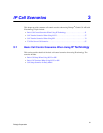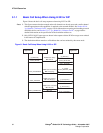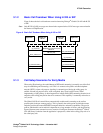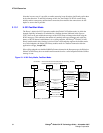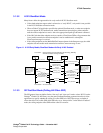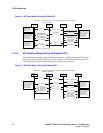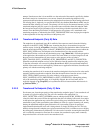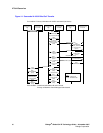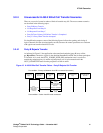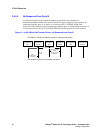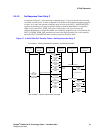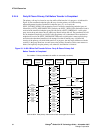Dialogic
®
Global Call IP Technology Guide — November 2007 57
Dialogic Corporation
IP Call Scenarios
3.2 Call Transfer Scenarios When Using H.323
The Dialogic
®
Global Call API API functions that support IP call transfer are described in the
Dialogic
®
Global Call API Library Reference. Information on implementing H.450.2 call transfer
can be found in Section 4.25, “Call Transfer”, on page 310, and protocol-specific information
about the individual call transfer APIs can be found in the subsections of Section 8.3, “Dialogic
®
Global Call API Function Variances for IP”, on page 444.
The following topics describe the call transfer capabilities provided when using the H.450.2
supplementary service with H.323:
• General Conditions for H.450.2 Call Transfers
• Endpoint Behavior in H.450.2 Blind Call Transfers
• Successful H.450.2 Blind Call Transfer Scenario
• Unsuccessful H.450.2 Blind Call Transfer Scenarios
• Endpoint Behavior in H.450.2 Supervised Call Transfer
• Successful H.450.2 Supervised Call Transfer Scenario
• Unsuccessful H.450.2 Supervised Transfer Scenarios
3.2.1 General Conditions for H.450.2 Call Transfers
When performing a call transfer operation, all involved call handles must be on the same stack
instance. This imposes the following application restrictions for call transfer operations:
• When performing a supervised call transfer at party A, both the consultation line device and
the transferring line device must be on the same virtual board.
• When performing a call transfer (either supervised or blind) at party B, both the transferring
line device and the transferred line device must be on the same virtual board.
• When performing a supervised call transfer at party C, both the consultation line device and
the transferred-to line device must be on the same virtual board.
3.2.2 Endpoint Behavior in H.450.2 Blind Call Transfers
This section describes the behavior of each of the three endpoints in an H.450.2 blind call transfer.
The assumed precondition for supervised call transfer is:
• The transferring endpoint (party A) and the transferred endpoint (party B) are participating in
an active call. From the perspective of the Dialogic
®
Global Call API, party A and party B are
both in the GCST_CONNECTED state.
3.2.2.1 Transferring Endpoint (Party A) Role
The transferring endpoint (party A) initiates the blind transfer by calling the gc_InvokeXfer( )
function, which results in the sending a ctInitiate.Invoke APDU (Application Protocol Data Unit,
the type of message used for H.450 supplementary services) within a Facility message. From this
point forward, this endpoint is only subsequently notified as to the creation of the transferred call





